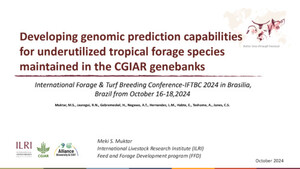
Genetic diversity in Napier grass (Cenchrus purpureus ) collections and progeny plants: Potential duplicates and unique genotypes
Abstract
Napier grass is an important perennial tropical grass grown as a forage and energy crop, however, it has a limited global diversity mainly due to its vegetative propagation. In this study, 345 Napier grass genotypes composed of 199 progeny plants raised from 13 seed-setting accessions, 19 accessions from USDA-ARS, 25 accessions from ICRISAT, 42 accessions from EMBRAPA, and 60 accessions from ILRI were investigated with the aim of enhancing the genetic diversity and increasing the population size of the Napier grass collection in the ILRI forage genebank. The plants were genotyped using the DArTseq genotyping by sequencing (GBS) method. A total of 96,321 SNP and 96,454 SilicoDArT genome-wide markers were generated. Of these, 85,619 (89 %) SNP and 73,573 (76 %) SilicoDArT markers were mapped onto the fourteen chromosomes of the Napier grass genome. Over 46% of the SilicoDArT and 35% of the SNP markers had a polymorphic information content (PIC) value above 0.25. Genetic diversity analysis using a subset of independent and highly polymorphic SNP markers detected moderate genetic variation among the collections, particularly between the progeny and the four collections, and indicated the presence of unique diversity in the progeny plants. The progeny plants clustered separately from the collections in multivariate analysis (UPGMA and PCA) and scattered across the PCA plot showing the high genetic variability within progeny plants. Variance components calculated by analysis of molecular variance (AMOVA) were also significant both among and within populations, however, more variation (90 %) was within than among populations (10 %). Multilocus genotype (MLG) analysis using Nei’s genetic distance identified 33 potential duplicates (0.02 threshold) suggesting the remaining 312 genotypes as distinct. Of these 312, 81 genotypes were selected as unique genotypes (0.26 threshold) by MLG analysis. The unique genotypes were mainly from progeny plants while the ILRI collection had most of the potential duplicates. The results of this study provide a useful information for the Napier grass breeding strategy and enhancement of genetic diversity in the ILRI collection. The results also provide a useful guide for the management and conservation of the collection in the ILRI forage genebank.
Citation
Muktar, M.S., Bizuneh, T., Wolde, B., Assefa, Y. and Jones, C.S. 2021. Genetic diversity in Napier grass (Cenchrus purpureus ) collections and progeny plants: Potential duplicates and unique genotypes. Poster prepared for Tropentag 2021 - Towards shifting paradigms in agriculture for a healthy and sustainable future, 15 September 2021. Nairobi, Kenya: ILRI.









